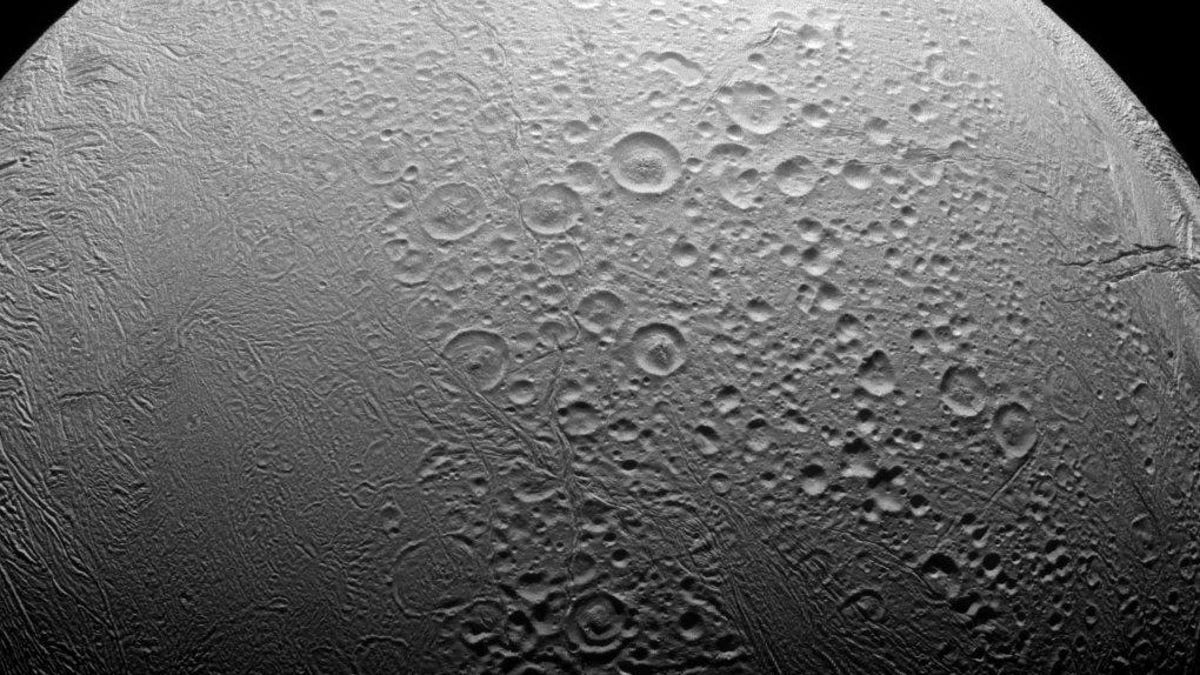Saturn moon Enceladus offers 'tantalizing' new hint it's habitable
Scientists have spotted complex organic molecules on the icy moon, ticking the last box on the checklist of items needed to support life.

We can now say there's at least one place beyond Earth that looks to have all the ingredients needed to support life. That place is just beyond the majestic rings of Saturn on the moon Enceladus, which looks to be just a big ball of ice in the outer solar system.
Looks do deceive, though.
Beneath its frozen shell lies a subsurface ocean that has some source of warmth and some very interesting chemistry going on. Last year, scientists used data from the now deceased Cassini spacecraft to determine that the basic building blocks of life, including molecular hydrogen, are present in Enceladus' ocean.
Now new research finds that much larger and more complex organic molecules can also be found there. This amounts to a big step forward in the search for alien life.
NASA's Cassini spacecraft flew through the plumes of icy material erupting through the surface of Enceladus from its hidden warm ocean.
"It shows that Enceladus is a habitable world and it would be a fantastic place to live if you're an organism," Christopher Glein of the Southwest Research Institute (SWRI) told me over the phone. "It completes the checklist of the essential ingredients for supporting life."
Glein is co-author of a paper outlining the new findings published in the journal Nature Wednesday. SWRI leads the team behind Cassini's ion and neutral mass spectrometer, which collected data on material from Enceladus' hidden ocean when the spacecraft flew through a plume erupting from the moon's surface. The instrument also looked at Saturn's E-ring, which is made up of ice grains from the plume.
It's too early, Glein said, to know what process forms the complex organic compounds, which measure at least 200 atomic mass units, making them 10 times heavier than methane. They could simply be leftovers from the formation of Enceladus and the rest of the solar system.
That's on the boring end of a very wide spectrum of feasible explanations. But there are more exciting possibilities, too.
"On the other end of the spectrum, this could be the remnant dead parts of organisms," Glein said. "It spans a huge range of possibilities, and that's why we really need to go back to figure how close to which end of the spectrum we really are on."
Glein stressed that although Enceladus can now be called habitable, there's still no evidence that it is in fact inhabited.
"We're still a ways from being able to answer that question," he said.
Finding that answer may require sending a new spacecraft with modern instruments back to Enceladus to look for evidence of alien biochemistry.
"This is a tantalizing first clue," Glein said. "A future spacecraft could fly through the plume of Enceladus, and analyze those complex organic molecules using a high-resolution mass spectrometer to help us determine how they were made."
NASA is planning a trip to Jupiter's moon Europa, which also has a subsurface ocean and plumes. A so-called Enceladus Life Finder spacecraft has been proposed to NASA, but the space agency has not yet decided to pursue it.
NASA could still opt to start up an Enceladus mission, but a private effort might beat it to the punch. The group Breakthrough Initiatives is looking into the possibility of getting a craft back to Saturn's system relatively quickly.
And of course, let's not forget that Elon Musk has told us that the SpaceX "BFR" rocket could go beyond just the moon and Mars to also explore the outer solar system as well.
The bottom line is that scientists are eager to sample whatever's cooking in Enceladus' subsurface stew, and if we're lucky we could have multiple outfits willing to supply the ride in the near future.
Technically Literate: Original works of short fiction with unique perspectives on tech, exclusively on CNET.
Crowd Control: A crowdsourced science fiction novel written by CNET readers.

